
The South Coast Botanic Garden is a 87 acres (35 ha) botanical garden in the Palos Verdes Hills, in an unincorporated area of Los Angeles County, California, United States, about 10 miles (16 km) south of Los Angeles International Airport. It has over 150,000 landscaped plants and trees from approximately 140 families, 700 genera, and 2,000 different species, including flowering fruit trees, Coast Redwoods, Ginkgos and Pittosporum. It is particularly rich in plants from Australia and South Africa. Its gardens include the Water-wise Garden, Herb Garden, English Rose Garden, and Garden of the Senses. A small lake and stream bed attract various birds such as ducks, geese, coots, and herons. Over 300 species of birds have been recorded. The lake is currently empty.

Pittosporaceae is a family of flowering plants that consists of 200–240 species of trees, shrubs, and lianas in 9 genera. Habitats range from tropical to temperate climates of the Afrotropical, Indomalayan, Oceanian, and Australasian realms. The type genus is Pittosporum Banks ex Gaertn.

Pittosporum is a genus of about 200 species of flowering plants in the family Pittosporaceae. The genus is probably Gondwanan in origin; its present range extends from Australasia, Oceania, eastern Asia and some parts of Africa. Citriobatus can be included here, but might be a distinct genus. They are commonly known as pittosporums or, more ambiguously, cheesewoods.

Hymenosporum is a monotypic genus in the family Pittosporaceae. The sole included species is Hymenosporum flavum, commonly known as native frangipani, which is a rainforest tree native to New Guinea, Queensland and New South Wales. Despite its common name, it is not closely related to the frangipani, but is related to the widespread genus Pittosporum.

Pittosporum undulatum is a fast-growing tree in the family Pittosporaceae. It is sometimes also known as sweet pittosporum, native daphne, Australian cheesewood, Victorian box or mock orange.
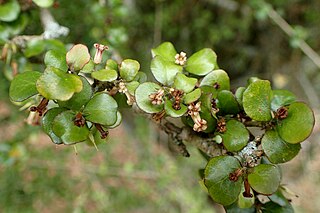
Pittosporum obcordatum, commonly called heart-leaved kohuhu or heart-leaved kohukohu or kohukohu, is a species of plant in the Pittosporaceae family. It is endemic to New Zealand, and exists both in North Island and South Island.

Pittosporum eugenioides, common names lemonwood or tarata, is a species of New Zealand native evergreen tree. Growing to 12 m (39 ft) tall by 5 m (16 ft) broad, it is conical when young but more rounded in shape when mature. Its leaves are mottled yellow-green with curly edges and a salient bright midrib, and have a strong lemony smell when crushed. It has highly fragrant clusters of attractive yellow-cream flowers in spring, followed by distinctive black seed capsules. It is found throughout New Zealand's North and South Islands along forest margins and stream banks from sea level to 600 m (1,969 ft). It is New Zealand's largest Pittosporum.

Pittosporum revolutum, the rough-fruited pittosporum, yellow pittosporum, Brisbane laurel or wild yellow jasmine, is a shrub that is endemic to Australia. The species grows up to 3 metres in height and has leaves that are 5 to 15 cm long and 1.5 to 6 cm wide. The fragrant, yellow flowers appear in terminal clusters in spring. It occurs in habitats ranging from rainforest to dry sclerophyll forests in Queensland, New South Wales and Victoria.
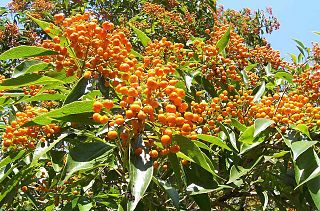
Auranticarpa is a genus of trees in the family Pittosporaceae. All six species occur in monsoonal forest and rainforest margins in Northern Australia. The species, all formerly included in the genus Pittosporum, are as follows:
Lyndley Alan Craven was a botanist who became the Principal Research Scientist of the Australian National Herbarium.

Pittosporum tobira is a species of sweet-smelling flowering plant in the pittosporum family Pittosporaceae known by several common names, including Australian laurel, Japanese pittosporum, mock orange and Japanese cheesewood. It is native to Japan, China, Taiwan, and Korea, but it is used throughout the world as an ornamental plant in landscaping and as cut foliage.

Pittosporum angustifolium is a shrub or small tree growing throughout inland Australia. Common names include weeping pittosporum, butterbush, cattle bush, native apricot, apricot tree, gumbi gumbi, cumby cumby, meemeei, poison berry bush, and berrigan.
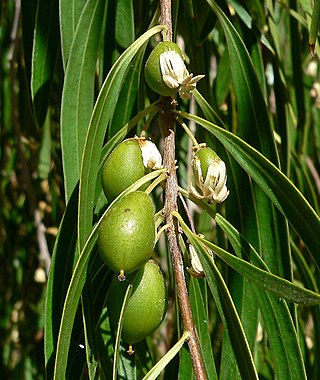
Pittosporum phillyreoides, with the common names weeping pittosporum and willow pittosporum, is a shrub or small columnar tree in the Apiales order, endemic to Australia.
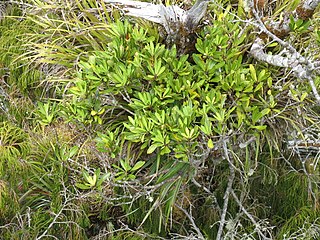
Pittosporum kirkii is a glabrous evergreen perennial shrub that reaches up to 5 metres (16 ft) in height and possesses distinctive coriaceous, fleshy, thick leaves. It is one of four shrubs endemic to New Zealand that frequently displays an epiphytic lifestyle. P. kirkii is commonly epiphytic, perched amongst nest epiphytes in the canopies of emergent or canopy trees in old-growth forest; however, it can be observed occasionally growing on the ground or over rocks. Kirk first observed P. kirkii on Great Barrier Island. It was described by Joseph Dalton Hooker from material collected by Thomas Kirk, possibly from the Thames Goldfields, and published in 1869. The initial brief description titled Pittosporum n. sp.? by Thomas Kirk was published in his paper on Great Barrier Island in 1868. This description along with herbarium specimens were sent to Dr. J. D Hooker at Kew Gardens in 1868, and he collaborated to name it after T. Kirk, by giving it the specific epithet kirkii within the publication that was otherwise written by Kirk.
Pittosporum mackeei is a species of plant in the Pittosporaceae family. It is endemic to New Caledonia.

Pittosporum heterophyllum, commonly known as Chinese Pittosporum, is a species of plant in the genus Pittosporum. Native to China and Tibet, it is a broadleaf evergreen shrub that grows to a maximum of 8–10 feet (2.4–3.0 m) tall. It has long been grown in gardens ornamentally, especially as a hedge or screen, in temperate gardens for its densely packed green foliage and the fragrant white to yellow flowers it produces in spring. As a landscaping plant, it is known for being more cold hardy than Pittosporum tobira and can be grown in hardiness zones 7-9 on the USDA scale.

Pittosporum ferrugineum, commonly known as the rusty pittosporum or rusty-leaved pittosporum, is an evergreen plant in the family Pittosporaceae native to Malesia, Papuasia, the Northern Territory and Queensland.
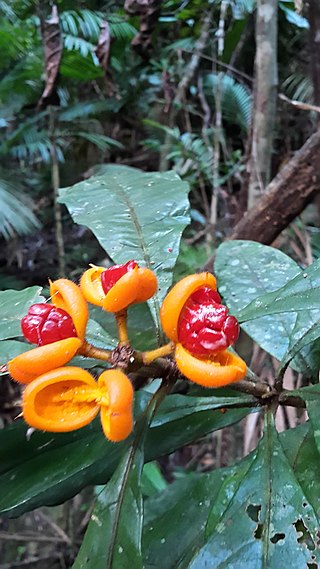
Pittosporum rubiginosum, commonly known as hairy red pittosporum, is an evergreen shrub in the family Pittosporaceae which is endemic to northeastern Queensland, Australia.















